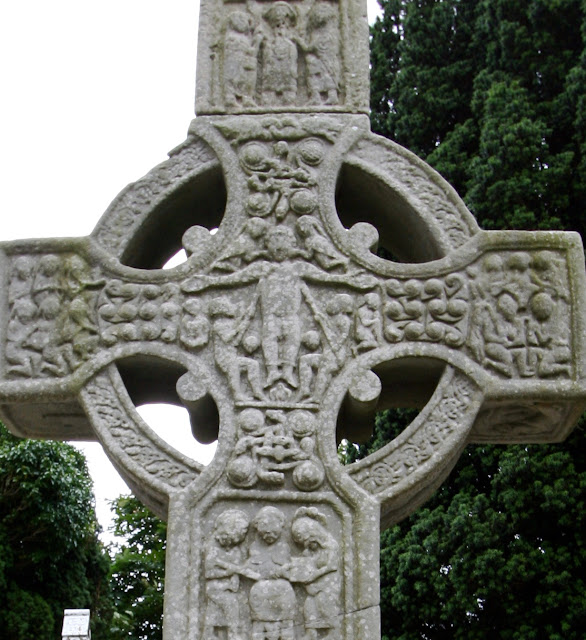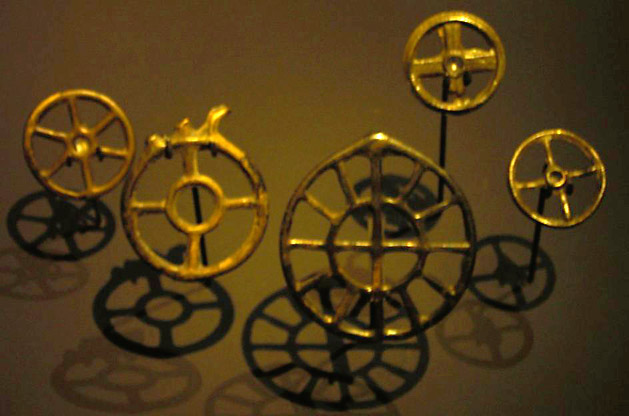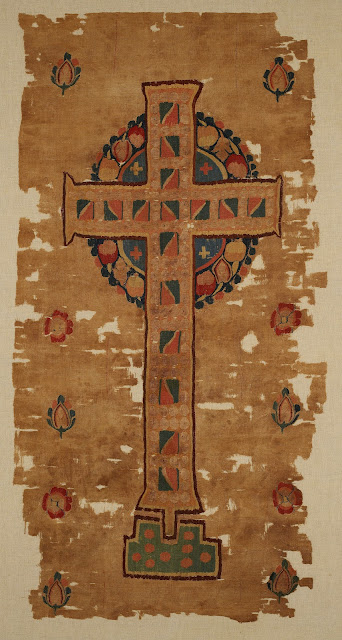Why are some Celtic crosses surrounded by a ring shape? If you ask this on an internet forum, the stock answer is that it's a leftover from the time of sun worship: some sort of compromise with the pagans. I have even heard it asserted that Celtic crosses existed before Christianity. So, I set out to find whether this was true. Turning to art history and archaeology, I found that there are no carved stone crosses in Ireland or Britain before the 8th century. The earliest surviving Irish standing high crosses, Pictish stones with crosses and Christian motifs, and the Northumbrian crosses all date to around 800 A.D. This is centuries after the Gospel was first proclaimed in the British Isles, well after the establishment of monasteries, and over 100 years after the Synod of Whitby.
The term "sun cross" was coined after World War II and refers to European Bronze Age sun chariot wheels created by sun worshiping cultures. As you can see, these are quite different objects altogether:
Celtic crosses were a new and unique development, separated from paganism by centuries. Even in the early days of Christianity it was an international religion. New ideas, writings, symbols, art, etc. travelled with the flow of missionaries, bishops, and pilgrims to and from Rome, the Holy Land, and the outer reaches of known human settlement. Taking a step back to Roman Christian art, we see many examples of the Chi Rho (Christ Monogram) surrounded by a victory wreath (derived from Emperor Constantine's
labarum).
In St. Paul's letter to the Corinthians, he compares the battle for self-mastery and perseverance in faith to an athlete striving to win a victor's crown: a wreath of laurel leaves. This is also the origin of images of martyred saints in heaven wearing laurel leaf crowns.
"Do you not know that in a race the runners all compete, but only one receives the prize? Run in such a way that you may win it. Athletes exercise self-control in all things; they do it to receive a perishable wreath, but we an imperishable one."-1 Corinthian 9:24-25
The most simple theory offered by some historians is that the ring shape around the Celtic cross is derived from this wreath and represents Christ's victory over death.
This large 5th century Coptic (Christian Egyptian) textile shows a wreath of leaves and fruit encircling the cross itself. Possibly used as a burial pall, it would have evoked the connection between Christ's sacrifice on the cross and His promises of victory over death and the rewards of eternal life for those that persevere in their faith.
Here the 12 fruits in the wreath could allude to the Tree of Life as described in St. John's Apocalypse (Revelation):
"In the midst of the street thereof, and on both sides of the river, was the tree of life, bearing twelve fruits, yielding its fruits every month, and the leaves of the tree were for the healing of the nations." -Revelation 22:2
In Genesis, Adam and Eve sinned by eating fruit from the Tree of Knowledge of Good and Evil. They were driven out of the Garden to prevent them from also eating fruit from the Tree of Life and thus living forever in their wretched fallen state. But in heaven, God promises:
"To him, that overcometh, I will give to eat of the tree of life" - Revelation 2:7
This is made possible by Christ's sacrifice on the cross to atone for mankind's sins as St. Peter writes:
"For unto this are you called: because Christ also suffered for us, leaving you an example that you should follow his steps. Who did no sin, neither was guile found in his mouth. Who, when he was reviled, did not revile: when he suffered, he threatened not: but delivered himself to him that judged him unjustly. Who his own self bore our sins in his body upon the tree: that we, being dead to sins, should live to justice: by whose stripes you were healed."
-1 Peter 2:21-24
St. Peter and St. John are making a mystical connection between Christ's cross, our healing from sin, and our eternal life in God's kingdom.
By the 6th century A.D., St. Venantius Fortunatus, Bishop of Poitiers wrote the hymn "Pange Lingua Gloriosi" which Catholics still sing during the Adoration of the Cross on Good Friday. The 8th verse reads:
Latin:
Crux fidelis, inter omnes arbor una nobilis,
nulla talem silva profert flore, fronde, germine,
dulce lignum dulce clavo dulce pondus sustinens.
English:
Faithful cross, true sign of triumph,
Be for all the noblest tree;
None in foliage, none in blossom,
None in fruit thine equal be;
Symbol of the world's redemption,
For the weight that hung on thee!
This brings us to one of the earliest known stone cross groups in Cardonagh, Ireland. Built near a church site said to be founded by St. Patrick, the Cardonagh crosses likely date to the 700's owing to stylistic similarities to the Book of Durrow.
The High Cross at Cardonagh marks a transition from stone slabs featuring a carved cross design to a free standing cross-shaped sculpture:
Near the High Cross stands the Marigold Stone. The so-called "marigold" is a tree of life bearing a ring shape and a heptagonal design, perhaps to represent the seven gifts of the Holy Spirit, the seven sacraments, etc. Sometimes wrongly identified as a flabellum, or liturgical fan, Conor Newman and Niamh Walsh make the case in their conference paper "Iconographical analysis of the Marigold Stone, Carndonagh, Inishowen, Co. Donegal" that it is indeed a tree of life and offer a highly detailed analysis of all the symbols.

On the side opposite of the Marigold stone is a cross with Christ ascending above. This deliberate juxtaposition links Christ's cross and His resurrection and Ascension with the tree of life.

Irish archaeologist Peter Harbison summarizes a third theory about the meaning of the ring around Irish high crosses in his book The Crucifixion in Irish Art:
"The crucifixion was, therefore, being interpreted by the Irish monks as the central event in the history of the cosmos, represented in symbolical form by the ring or circle of the cross." -Harbison, page 4.
Harbison is describing the crucifixion scene on Muiredach's Cross at Monasterboice from the late 9th century (see image at top). Christ is flanked by two soldiers, two angels, and the sun and moon are at his knees. These elements are pretty standard in medieval depictions of the crucifixion. The large outer ring definitely cannot represent the sun if the sun is already represented inside the composition. In medieval cosmology, the outer bounds of the universe are a dome in which the stars are embedded and which rotates around the earth. This image of Christ at the center of the cosmos represents His utmost importance. The crucifixion scene is supported by a myriad of other scenes and figures from the Bible.
This interpretation seems to be supported by 5th century Irish poet Sedulius, who wrote an epic poem about the Gospel, "Carmen Paschale" (The Easter Song). His passage about the crucifixion calls to mind this imagery of Christ at the center of the cosmos embracing the earth:
From The Easter Song of Sedulius, translated by George Sigerson via archive.org
So here we have three possibilities for the meaning of the ring shape around Irish high crosses based on archeological and textual evidence. None of them relate to sun worship. All of them are fruitful for contemplating the divine mysteries of death, resurrection, and eternal life.
Main image: Muiredach's Cross at Monasterboice, County Louth. Sitoman, CC-By-SA-2 via Wikimedia Commons.




.jpg)




Comments